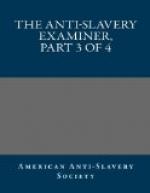Mr. James Kimborough, Memphis, Tenn. in the “Memphis Enquirer” July 13, 1838.
“Ranaway, a negro boy, named Jerry—has a scar on his right check two inches long, from the cut of a knife.”
Mr. Robert Beasley, Macon, Georgia, in the “Georgia Messenger”, July 27, 1837.
“Ranaway, my man Fountain—has holes in his ears, a scar on the right side of his forehead—has been shot in the hind parts of his legs—is marked on the back with the whip.”
Mr. B.G. Barrer, St. Louis, Missouri, in the “Republican”, Sept. 6, 1837.
“Ranaway, a negro man named Jarret—has a scar on the under part of one of his arms, occasioned by a wound from a knife.”
Mr. John D. Turner, near Norfolk, Virginia, in the “Norfolk Herald”, June 27, 1838.
“Ranaway, a negro by the name of Joshua—he has a cut across one of his ears, which he will conceal as much as possible—one of his ankles is enlarged by an ulcer.”
Mr. William Stansell, Picksville, Ala. in the “Huntsville Democrat”, August 29, 1837.
“Ranaway, negro boy Harper—has a scar on one of his hips in the form of a G.”
Hon. Ambrose H. Sevier Senator, in Congress, from Arkansas in the “Vicksburg Register”, of Oct. 18.
“Ranaway, Bob, a slave—has a scar across his breast, another on the right side of his head—his back is much scarred with the whip.”
Mr. R.A. Greene, Milledgeville, Georgia, in the “Macon Messenger” July 27, 1837.
“Two hundred and fifty dollars reward, for my negro man Jim—he is much marked with shot in his right thigh,—the shot entered on the outside, half way between the hip and knee joints.”
Benjamin Russel, deputy sheriff, Bibb county, Ga. in the “Macon Telegraph”, December 25, 1837.
“Brought to jail, John—left ear cropt.”
Hon. H Hitchcock, Mobile, judge of the Supreme Court, in the “Commercial Register”, Oct. 27, 1837.
“Ranaway, the slave Ellis—he has lost one of his ears.”
Mrs. Elizabeth L. Carter, near Groveton, Prince William county, Virginia, in the “National Intelligencer”, Washington, D.C. June 10, 1837.
“Ranaway, a negro man, Moses—he has lost a part of one of his ears.”
Mr. William D. Buckels, Natchez, Mi. in the “Natchez Courier,” July 28, 1838.
“Taken up, a negro man—is very much scarred about the face and body, and has the left ear bit off.”
Mr. Walter R. English, Monroe county, Ala. in the “Mobile Chronicle,” Sept. 2, 1837.
“Ranaway, my slave Lewis—he has lost a piece of one ear, and a part of one of his fingers, a part of one of his toes is also lost.”
Mr. James Saunders, Grany Spring, Hawkins county, Tenn. in the “Knoxville Register,” June 6, 1838.
“Ranaway, a black girl named Mary—has a scar on her cheek, and the end of one of her toes cut off.”




